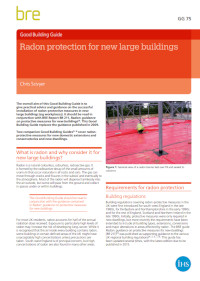Radon protection for new large buildings GG 75
BRE (Building Research Establishment) is an independent, research-based consultancy, testing and training organisation, operating in the built environment and associated industries.
Radon protection for new large buildings (GG 75 revised) was written by Chris Scivyer and published by BRE on 13 January 2015.
Radon is a natural, colourless, odourless, radioactive gas formed by the radioactive decay of the small amounts of uranium that occur naturally in all rocks and soils. It can move through cracks and fissures in the subsoil and eventually to the atmosphere. Most of this radon will disperse harmlessly, but some will collect in spaces under or within buildings.
For most UK residents, radon accounts for half the annual radiation they receive. Exposure to particularly high levels of radon may increase the risk of developing lung cancer. While it is recognised that the air inside every building contains radon, some buildings in certain areas of the UK might have unacceptably high concentrations unless precautions are taken. South-west England is of principal concern, but high concentrations of radon are also found in other areas.
Building regulations covering radon-protective measures in the UK were first introduced for south-west England in the late 1980s, for Derbyshire and Northamptonshire in the early 1990s and for the rest of England, Scotland and Northern Ireland in the late 1990s. Initially, protective measures were only required in new dwellings, but more recently the requirements have been extended to include all building types, extensions, conversions and major alterations in areas affected by radon.
This 8-page Good Building Guide gives practical advice about the installation of radon-protective measures in new large buildings (eg workplaces). It replaces the guidance published in 2009 and should be read in conjunction with BRE Report BR 211, Radon: guidance on protective measures for new buildings.
Its contents are:
- What is radon and why consider it for new large buildings?
- Requirements for radon protection and radon reduction.
- Protective measures.
- Basic radon protection.
- Full radon protection.
- Radon barriers.
- High water table and tanking to basements and cellars.
- Subfloor ventilation.
- Subfloor depressurisation and sumps.
- Monitoring completed buildings.
- References.
- Further reading.
[edit] Related articles on Designing Buildings Wiki
- BRE articles on Designing Buildings Wiki.
- BRE Buzz articles on Designing Buildings Wiki.
- BRE Buzz.
- BREEAM.
- Building Research Establishment.
- Methane and other gasses from the ground.
- Radon.
- Radon: Guidance on protective measures for new buildings BR 211.
- Radon protection for new domestic extensions and conservatories with solid concrete ground floors (GG 73 revised).
- Radon protection for new dwellings GG 74.
- Radon solutions in older homes GR 38.
- Site appraisal.
- Site investigation.
- Soil survey.
- Solid and liquid contaminants risk assessments.
- Subfloor.
Featured articles and news
RTPI leader to become new CIOB Chief Executive Officer
Dr Victoria Hills MRTPI, FICE to take over after Caroline Gumble’s departure.
Social and affordable housing, a long term plan for delivery
The “Delivering a Decade of Renewal for Social and Affordable Housing” strategy sets out future path.
A change to adoptive architecture
Effects of global weather warming on architectural detailing, material choice and human interaction.
The proposed publicly owned and backed subsidiary of Homes England, to facilitate new homes.
How big is the problem and what can we do to mitigate the effects?
Overheating guidance and tools for building designers
A number of cool guides to help with the heat.
The UK's Modern Industrial Strategy: A 10 year plan
Previous consultation criticism, current key elements and general support with some persisting reservations.
Building Safety Regulator reforms
New roles, new staff and a new fast track service pave the way for a single construction regulator.
Architectural Technologist CPDs and Communications
CIAT CPD… and how you can do it!
Cooling centres and cool spaces
Managing extreme heat in cities by directing the public to places for heat stress relief and water sources.
Winter gardens: A brief history and warm variations
Extending the season with glass in different forms and terms.
Restoring Great Yarmouth's Winter Gardens
Transforming one of the least sustainable constructions imaginable.
Construction Skills Mission Board launch sector drive
Newly formed government and industry collaboration set strategy for recruiting an additional 100,000 construction workers a year.
New Architects Code comes into effect in September 2025
ARB Architects Code of Conduct and Practice available with ongoing consultation regarding guidance.
Welsh Skills Body (Medr) launches ambitious plan
The new skills body brings together funding and regulation of tertiary education and research for the devolved nation.
Paul Gandy FCIOB announced as next CIOB President
Former Tilbury Douglas CEO takes helm.
UK Infrastructure: A 10 Year Strategy. In brief with reactions
With the National Infrastructure and Service Transformation Authority (NISTA).
























